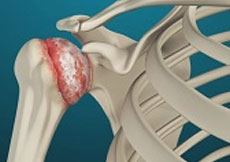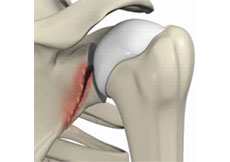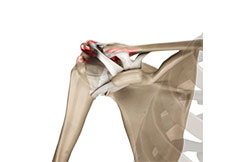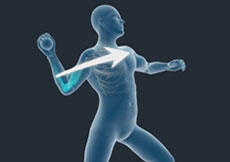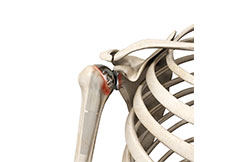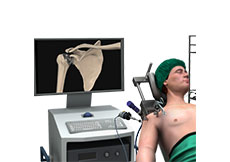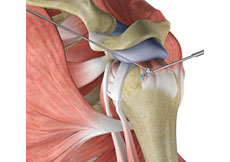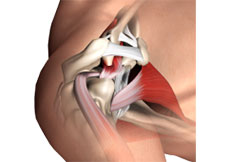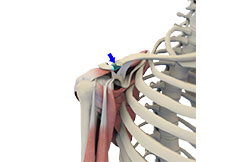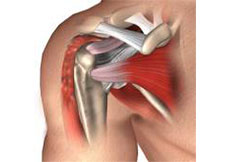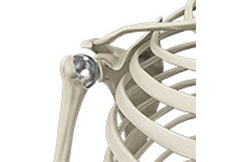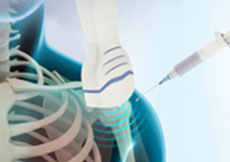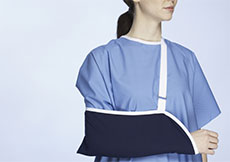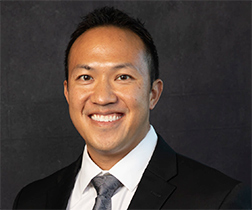-
Arthritis of the Shoulder
The term arthritis literally means inflammation of a joint but is generally used to describe any condition in which there is damage to the cartilage. Damage of the cartilage in the shoulder joint causes shoulder arthritis. Inflammation is the body's natural response to injury. The warning signs that inflammation presents are redness, swelling, heat, and pain.
-
Shoulder Instability / Shoulder Dislocation
Shoulder instability is a chronic condition that causes frequent dislocation of the shoulder joint.
-
Frozen Shoulder
Frozen shoulder, also called adhesive capsulitis, is a condition in which you experience pain and stiffness in your shoulder. The symptoms appear slowly, worsen gradually and usually take one to three years to resolve on their own.
-
Rotator Cuff Injury or Tear
The rotator cuff consists of a group of tendons and muscles that surround and stabilize the shoulder joint. These tendons allow a wide range of movement of the shoulder joint across multiple planes. Irritation or injury to these tendons can result in rotator cuff pain.
-
Other Shoulder Tendon Injuries
Several tendons attach to the shoulder to provide support and enable a wide range of motion. These tendons are: rotator cuff tendons, biceps tendons, triceps tendons and pectoralis tendons. A major injury to these tendons may result in tendon tears.
-
Shoulder Fracture
A break in a bone that makes up the shoulder joint is called a shoulder fracture. The clavicle and end of the humerus closest to the shoulder are the bones that usually get fractured. The scapula, on the other hand, is not easily fractured because of its protective cover by the surrounding muscles and chest tissue.
-
Acromioclavicular (AC) Arthritis
The acromioclavicular joint is part of the shoulder joint. It is formed by the union of the acromion, a bony process of the shoulder blade, and the outer end of the collar bone or clavicle. The joint is lined by cartilage that gradually wears with age as well as with repeated overhead or shoulder level activities such as basketball.
-
Sports Injuries of the Shoulder
Sports injuries of the shoulder are injuries sustained while playing indoor or outdoor sports such as baseball, tennis, football, basketball and golf, or while exercising.
-
Shoulder Pain
Pain in the shoulder may suggest an injury, which is more common in athletes participating in sports such as swimming, tennis, pitching, and weightlifting. The injuries are caused due to the over usage or repetitive motion of the arms.
-
Periprosthetic Shoulder Infection
A periprosthetic shoulder joint infection is a very rare, but devastating complication of shoulder replacement surgery characterized by infection of the tissues surrounding your shoulder prosthesis.
-
Minimally Invasive Shoulder Joint Replacement
Shoulder joint replacement is a surgical procedure that replaces damaged bone surfaces with artificial humeral and glenoid components to relieve pain and improve functional ability in the shoulder joint.
-
Reverse Shoulder Replacement
Conventional surgical methods such as total shoulder joint replacement are not very effective in the treatment of rotator cuff arthropathy. Reverse total shoulder replacement is an advanced surgical technique specifically designed for rotator cuff tear arthropathy, a condition where you suffer from both shoulder arthritis and a rotator cuff tear.
-
Revision Shoulder Replacement
Total shoulder replacement usually has good results, but a revision surgery may occasionally be necessary due to persistent pain, infection, stiffness, weakness, instability, hardware loosening, malposition or fracture.
-
Shoulder Arthroscopy
Arthroscopy is a minimally invasive diagnostic and surgical procedure performed for joint problems. Shoulder arthroscopy is performed using a pencil-sized instrument called an arthroscope. The arthroscope consists of a light system and camera that projects images of the surgical site onto a computer screen for your doctor to clearly view.
-
Shoulder Fracture Fixation
A break in the bone that makes up the shoulder joint is called a shoulder fracture. The clavicle (collarbone) and end of the humerus (upper arm bone) closest to the shoulder are the bones that usually are fractured. The scapula, or shoulder blade, is not easily fractured because of its protective cover of surrounding muscles and chest tissue.
-
Rotator Cuff Repair
Rotator cuff repair is a surgery to repair an injured or torn rotator cuff. It is usually performed arthroscopically on an outpatient basis. An arthroscope, a small, fiber-optic instrument consisting of a lens, light source, and video camera. The camera projects images of the inside of the joint onto a large monitor, allowing your doctor to look for any damage, assess the type of injury and repair it. Large rotator cuff tears may require open surgery.
-
Subacromial Decompression
Subacromial decompression is a surgical procedure performed for the treatment of a condition called shoulder impingement. In shoulder impingement, the degree of space between the rotator cuff tendon and shoulder blade is decreased due to irritation and swelling of the bursa or due to development of bone spurs. Subacromial decompression opens this space by removing the bony spurs or any inflamed or swollen bursa enabling free shoulder movement.
-
Distal Clavicle Excision
Distal clavicle excision is a procedure which involves removal of the outer end of the clavicle (collarbone) to treat shoulder pain and disability due to arthritis or impingement.
-
Proximal Biceps Tenodesis
Proximal biceps tenodesis is the surgical reattachment of a torn proximal biceps tendon, which connects the upper part of your biceps muscle to the shoulder.
-
Other Shoulder Tendon Repair Procedures
Several tendons attach to the shoulder to provide support and enable a wide range of motion. These tendons are: rotator cuff tendons, biceps tendons, triceps tendons and pectoralis tendons. A major injury to these tendons may result in tendon tears.
-
Shoulder Instability Stabilization
Shoulder instability is a chronic condition that causes frequent dislocation of the shoulder joint. A dislocation occurs when the end of the humerus (the ball portion) partially or completely dislocates from the glenoid (the socket portion) of the shoulder. A partial dislocation is referred to as a subluxation while a complete separation is referred to as a dislocation.
-
Shoulder Resurfacing
The shoulder is an active joint is prone to injuries and may also get affected by conditions such as arthritis, which results in impaired functioning and related discomfort. The traditional method of treatment for such conditions is shoulder joint replacement. However, advances in technology have resulted in a superior alternative technique known as shoulder resurfacing.
-
Ultrasound-Guided Shoulder Injections
An ultrasound-guided injection is a minimally invasive procedure used for: Treating various painful musculoskeletal conditions such as tendonitis, bursitis, and neuritis Performing cyst aspiration Guiding the placement of needles for both diagnostic as well as therapeutic purposes.
-
Non-surgical Shoulder Treatments
Shoulder injuries can often be treated by non-surgical methods including the following:
- Resting the Affected Shoulder
- Ice and Heat Treatment
- Medications
-
Howard W. Harris, M.D.Shoulder
-
Michael L. Nguyen, M.D.Shoulder &
Sports Medicine -
Katherine C. Bartush, M.D.Sports Medicine
Foot & Ankle


